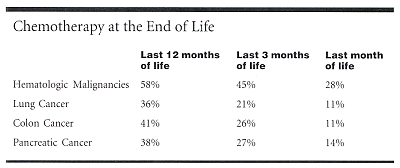Chemotherapy Common at End of Life
SAN FRANCISCO-More than four out of 10 cancer patients received chemotherapy during their last year of life, according to a study of Medicare patients in Massachusetts. Even a proportion of patients with tumors considered unresponsive to chemotherapy received treatments within 1 month of their death.
SAN FRANCISCOMore than four out of 10 cancer patients received chemotherapy during their last year of life, according to a study of Medicare patients in Massachusetts. Even a proportion of patients with tumors considered unresponsive to chemotherapy received treatments within 1 month of their death.
Ezekiel J. Emanuel, MD, PhD, chief of the Department of Clinical Bioethics at the Clinical Center of the National Institutes of Health, characterized the use of late-in-life chemotherapy as substantial and surprising. It was also associated with increased medical costs of more than $10,000. Surprisingly, patients receiving such chemotherapy were more likely to be placed in hospice, he added, but for a shorter time than patients who had not received chemotherapy.
"There’s widespread perception that oncologists overtreat terminally ill cancer patients with chemotherapy. Oncologists usually counter that use of chemotherapy is judicious, and they only give it where the patient is likely to benefit or to improve the quality of life," said Dr. Emanuel. He explained that the study was undertaken in the absence of data in the literature to support either position.
He cautioned that the investigators relied on financial records that presented no information about why chemotherapy was used. Among the many possible explanations, he said, are uncertain prognosis, tumor responsiveness, palliation, experimental chemotherapy, and patient and family demand for chemotherapy.
Most Common for Hematologic Malignancies
Scientists from Harvard Medical School, Boston University School of Medicine, and Harvard Vangard Medical Associates, all in Massachusetts, joined in the study, which linked Health Care Financing Administration (HCFA) files to 1996 death certificates from Massachusetts. They found 34,131 death certificates for Medicare recipients, and tracked medical bills for 7,919 people whose certificates listed cancer as the primary cause of death.
Dr. Emanuel reported that 41% of the cancer patients received chemotherapy during the last year of life, 26% during the last 3 months, and 14% during the last month. Patients with hematologic malignancies were most likely to receive chemotherapy; 58% received it during the last year, 45% during the last 3 months, and 28% during the last month:

While chemotherapy was less common for patients with solid tumors, Dr. Emanuel said the rates were similar for cancers known to respond to chemotherapy and those that do not. Categorizing breast, colon, and ovarian cancer as responsive to chemotherapy, Dr. Emanuel reported that 41% of colon cancer patients received chemotherapy during the last 12 months of life, 26% during the last 3 months, and 11% during the last month. For pancreatic cancer, the rates were similar: 38%, 27%, and 14%, respectively. Yet pancreatic cancer was classified as unresponsive along with renal cell, gall bladder, liver cancers, and melanoma. Prostate and lung cancers were not placed in either group.
Duration of chemotherapy was less for the patients with cancers in the unresponsive group. Among patients with responsive cancers, 62% received more than 1 month of chemotherapy and more than 25% received 6 months. More than 50% of patients with unresponsive cancers underwent chemotherapy for 1 month or less.
Age Also a Factor
Age also appeared to be factor. A higher proportion of younger cancer patients had chemotherapy during the last year of life: 54% of patients ages 65 to 74, 39% of those ages 75 to 84, and 23% of those 85 and over. Similar proportions of male and female patients were reported: 43% vs 39%.
Costs were 32.5% higher for those who received chemotherapy during the last year: $38,308 compared to $27,567 for those who did not. Dr. Emanuel said the cost difference was higher for patients with chemotherapy-responsive cancers than for those with cancers categorized as unresponsive: 45% vs 20%. He suggested that patients with chemotherapy-responsive cancers might have had higher costs because they received more treatment and were more likely to be hospitalized.
Hospice Relationship
"The relationship between use of chemotherapy and use of hospice is complex," he continued. About one third of cancer patients overall used hospice, but the proportion was higher among the patients who received chemotherapy (38% vs 29%), and those who entered hospice after chemotherapy used the service for a shorter time.
Dr. Emanuel offered a hypothesis for the relationship between chemotherapy and hospice. "A simple rule is that users of medical services are users of medical services and hospice is one additional medical service," he said. "When you try chemotherapy and it doesn’t work, hospice is the next thing that is done."
Deborah Schrag, MD, of Memorial Sloan-Kettering Cancer Center in New York City, commented on the study. She said that standards are lacking and controversial for what utilization rate represents appropriate use of chemotherapy. "The question here," she said, "is, did the doctors know these patients were terminally ill or not when they made these decisions? And that we just can’t know because of the way this cohort was ascertained."
Late Hepatic Recurrence From Granulosa Cell Tumor: A Case Report
Granulosa cell tumors exhibit late recurrence and rare hepatic metastasis, emphasizing the need for lifelong surveillance in affected patients.